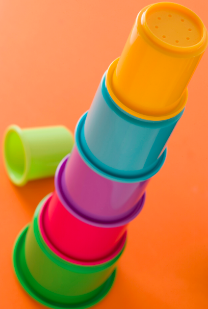Play and Language Development with Everyday Objects: Cups!
If you are looking for new ways to facilitate play and language development, look no further than your own home. There is no need to buy more pricey toys; you can create novel and exciting play activities with everyday items you already own.
Here are 5 ways to target expressive and receptive language development through play using plastic cups.
- Stack the cups
Build a tower by stacking cups as high as you can, count to 3 and then knock them down. This simple activity can target a variety of language skills, such as requesting (“want more”, “more up”), spatial concepts (“put on”, “take off”, “fall down”), asking for help and turn taking. - Hide and seek

Lay 3 cups on the floor and hide a ball or any small object under one of them. Tell your child to look under the cups to find the surprise! You can even tape letters or pictures on the outside of the cups to work on pre-literacy skills and vocabulary. Language skills to target during this activity can include asking questions (“where’s the ball?”), understanding spatial concepts (“look under the cup”), answering yes/no questions (“Is there a ball under there?”), following 1-step directions (“Give the cup to me”), the options are endless!!!! - Arts and Crafts
Dip the rims of the cups into paint and then stamp them onto paper to make circles. Play with different paint colors, use markers to draw faces in the circles, turn the circles into a caterpillar, monster or ladybug or even find stamps of different sizes around the house (ex: toilet paper role, marker lids, bottle caps, Dixie cups, etc.). You can maximize your child’s creativity while targeting language skills such as following directions (“stamp on the top of the paper”), requesting items, describing the size, shape and color of the circles and materials, expanding utterance length and making choices (“Do you want red paint or blue paint?”). - Water Play
Fill up a bucket of water or play with the cups at the sink or in the bathtub. Scoop up the water, dump it out, give plastic toys a bath or even poke holes in the cups if they are disposable and you’re playing outside. This sensory play activity is a great way to target using new action words, like scoop, spill and dump, as well as descriptor words like wet, dry, full, empty, cold and warm. - Pretend play
Have a tea party or picnic with the cups. Find stuffed animals to join the party and give them each something to drink. Your child can pretend to pour a beverage, put ice cubes (i.e., blocks or squares of paper) in the cups, talk about what you are drinking, request a straw or mix up something new. You can use pretend food or bowls and spoons from your kitchen to pretend to cook soup or bake cookies. You can pretend the cups are party hats, rocket ships or even drums. This encourages symbolic and interactive play skills as well as use of pronouns (“my cup”, “your soup”), turn taking, sharing and exposure to new vocabulary words.
Taking a simple household object and getting creative with it will give you hours and hours of fun, imagination development and above all LANGUAGE development! Enjoy playing with your child during this time to expose them to different concepts! Don’t worry if they are not answering or repeating all that you are showing them! Their little brains are working hard and processing new concepts! Keep showing them how fun it is to explore! Happy playing!


